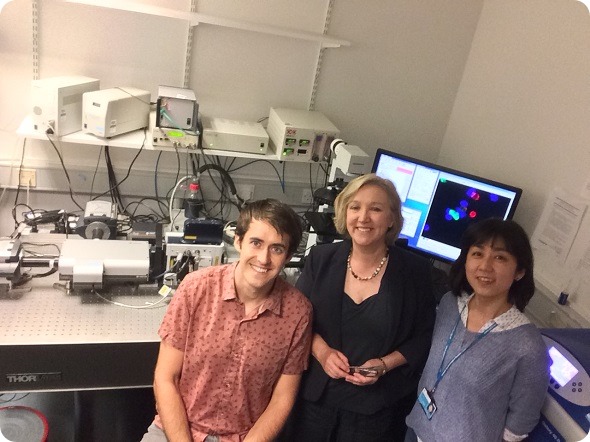Sep 15 2015
Although much is known of the immune response to antigen-presenting cells, until now the way the body's own killer cells establish an immunological synapse to destroy those target cells has remained unclear. Now, an international research team led by Professor Gillian Griffiths of Cambridge University has resolved the key sequence of events using high-resolution 4D imaging.

Image and Revolution Microscope, displayed behind the Cambridge University team
The resulting movies, captured on an Andor Revolution confocal spinning disk microscope equipped with iXon EMCCD cameras, are the first to demonstrate the killing machinery organising itself within the cytotoxic T lymphocytes (CTLs) as they prepare for attack. As well as revealing a critical role for actin reorganization in this complex process, the researchers believe it could lead to more effective cancer treatments.
Professor Gillian Griffiths, explaining that killer cells had only previously been imaged in flat 2D images, which made it impossible to clearly discern events inside these cells, said:
This is the first time that this process has been captured in 3D. The Andor Revolution confocal microscope enabled us to use new high-resolution 4D imaging techniques to capture images across the entire cell, visualising the changes inside these cells that enable them to kill, with a spatial and temporal resolution not seen before."
"We use the Andor Revolution and Andor's Imaris software for all of the imaging from my lab", continues Gillian. "I compared offerings from many other companies and found that Andor was the fastest to capture the stack across the cell and had the least photobleaching. The Andor cameras were key, as was the expertise of the Andor staff in listening to what we were trying to achieve and putting together a system that allowed us the speed and resolution that we needed.”
"For fixed samples, the system is preferred over the standard confocals in the core facility as it is much faster to take the stacks. We have also recently upgraded to a dual-camera system, which has yielded an approximately 5-fold speed improvement."
According to Geraint Wilde of Andor, an Oxford Instruments company, the critical role for actin reorganization in initiating centrosome polarization and granule secretion is a critical finding. "The insights provided by this level of three dimensional dynamic imaging will allow us to understand the molecular mechanisms that control killer cells, and hold out the hope for improved cancer treatments. In elucidating the changes inside these cells that lead to killing, researchers will be able to find out why killer cells cannot control some cancers. In time you would then hope to be able to identify ways in which killer cells can be made more effective."
Andor's microscopy systems and scientific cameras address a broad range of optical microscopy techniques including laser spinning disk confocal microscopy, photo-bleaching, activation, conversion and ablation, TIRF, white light spinning disk confocal, calcium ratio imaging, comet assay and bioluminescence.
Reference
Alex T. Ritter, Yukako Asano, Jane C. Stinchcombe, N.M.G. Dieckmann, Bi-Chang Chen, C. Gawden-Bone, Schuyler van Engelenburg, Wesley Legant, Liang Gao, Michael W. Davidson, Eric Betzig, Jennifer Lippincott-Schwartz, and Gillian M. Griffiths. "Actin Depletion Initiates Events Leading to Granule Secretion at the Immunological Synapse," Immunity 42, 864-876 (2015).
Source: Andor